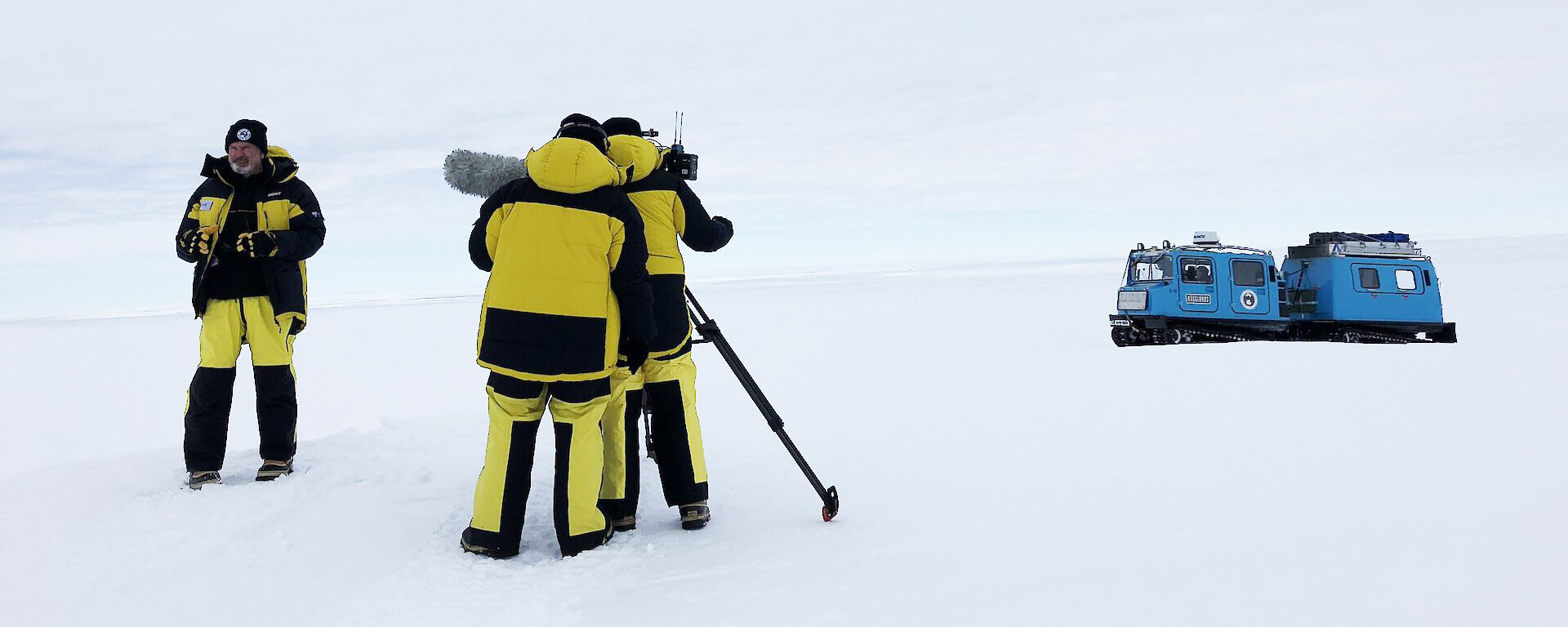Antarctic video gallery
Whale research video
Video transcript
Australian Antarctic Division whale scientist Dr Elanor Bell
We were studying humpback and minke whales, specifically looking at their foraging ecology, which means where they feed, how they feed, where they're travelling to in order to feed, and looking at their prey as well. We deployed two different types of tag. The first was a video suction cup tag, which has all sorts of really specialist motion sensors inside it as well as a video camera at the front. We were deploying those on the sleepy logging whale at the surface. We’d sort of creep up to them in the boat, we’d slap a tag on their back.
The video records where the whales – where they're going, how deep they're diving, and what they're actually eating. So you see footage of them actually lunging at dense krill swarms in the open water. The limpet tags are different. They are small implantable tags that we were deploying on the minke whales. They stay in the dorsal fin for up to two months, and they transmit the location data and dive data from that whale. And we want to understand what they need, and how these climate changes or these other anthropogenic changes might impact the whales in the future.
[end transcript]
Adélie penguin population
Video transcript
Seabird Ecologist — Dr Louise Emmerson
The purpose of this work was to bring together various elements of research to try and identify what pressures or threats there were on the Antarctic breeding seabirds. For this work, we were particularly focusing on the terrestrial environment where the birds were breeding, as well as the marine environment where the birds were foraging.
We used a long term 25-year mark re-sight program to try and estimate how many non-breeders there were in the population, and how this number related to the number of breeders.
So we estimate that the total population, which comprises of the breeders and the non-breeders, is around 5.9 million birds in East Antarctica. When we extrapolate that out to the entire continent, that’s between 14 to 16 million birds.
In East Antarctica, the Adélie penguins are primarily eating krill but they also eat some fish as well, and we're trying to understand exactly how much of that has any overlap with potential fishing industry.
There were a lot of breeding Adélie penguins within very close proximity to the Antarctic stations. The Adélie penguins are trying to find locations to breed, which are ice-free and they're very close to open water. Our results can be used to identify areas which may need enhanced protection in the future.
[end transcript]
Insightful approach to aging Antarctic krill
Video transcript
Dr So Kawaguchi: This is very exciting. Knowing the age of krill is a very very long research questions — more than 50 years, because krill doesn’t have any hard parts that record their age. To find out their age, we used eye stalks.
What we did was to slice those eye stalks into really thin slices and then polish it, and then count the annual bands that have been created. The concept is the same as the annual tree rings.
Krill is the fundamental food source for most of the higher predators, like whales, penguins, seals, in the Antarctic Ocean.
If there’s any change in krill populations, that will certainly have a fundamental impact in the structure of the ecosystem itself. So it’s really important to know how old the krill are, because that will be used for the fisheries management. We can actually retrospectively go in to preserve samples, like about a hundred years ago, and then compare with the recent krill — we'll be able to better predict what may happen in this changing environment into the future.
[end transcript]
Nuyina cranes and funnels
Video transcript
Text box: Nuyina’s two 55 tonne cranes have been installed.
Text box: The external cladding of the funnels is lowered into place.
[end transcript]
Under the sea ice in Antarctica
Video transcript
Glenn Johnstone — biologist
We’re diving under the sea ice in O’Brien Bay, south of Casey research station in East Antarctica.
This is a thriving, colourful world filled with sponges, sea cucumbers, sea spiders, worms, algae and starfish.
Here we are at 30m below the surface, where the water temperature is a chilly −1.5°C year round, and the sea is covered by ice that is a metre and a half thick for more than 10 months of the year. This ice provides protection from Antarctica’s harsh weather conditions and a stable marine environment that allows biodiversity to flourish.
It is important biodiversity like you see here that is the focus of our research into the effects of climate change and ocean acidification.
Here at the Australian Antarctic Division, we are working hard to ensure the continent remains valued, protected and understood.
[end transcript]


